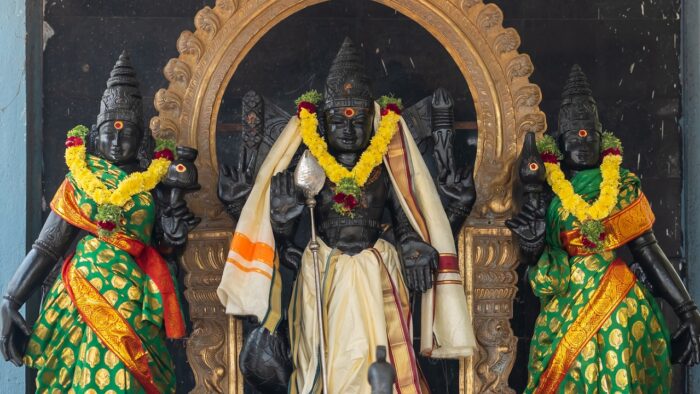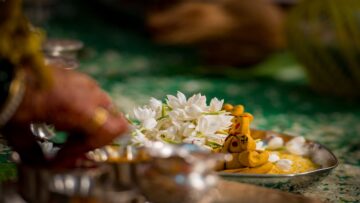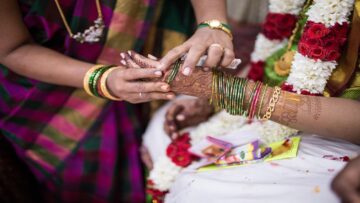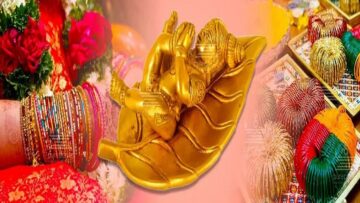पुत्रात्इच्छेत्पराजयम्।[1]
Meaning- Even defeat is sweet if faced at the hands of one’s own child. (The same can be said of pupils but the topic here is from the perspective of parents). One can personally decide and make efforts to nurture their own children gradually right from the time of copulation[2]. The Saṃskāras can be used to fortify and inculcate noble qualities that are necessary to uplift one’s family as well as society.
Let us contemplate the birth of Kārtikeya. Everyone wants a child like Kārtikeya, i.e., a child who is better than his/her parent. (In terms of knowledge, character, and skill.) The ĀdiDampati (the eternal couple) Śiva and Pārvatī were united by destiny to save the world from the wrath of Śūrapadma, an Asura.
Later, Kārtikeya was born, and the rest is mentioned in KārtikeyaJananam (The birth of BhagavānKārtikeya).[3]
Previously, we had read that a child’s life is endangered till the age of twenty.[4]So, an Āyuṣya/MṛtyuñjayaHoma has been suggested each year till the twelfth birthday. (At least for a minimum of three years, it should be done followed by Arcanās and charity on every annual JanmaNakṣatra day. Other alternatives are suggested by the Śāstras and advice can be received from concerned Purohits.) For example, the lungs take around eight years after birth to develop fully as per embryology. The lungs’ strength is determined by both modern medical and Śāstric intervention. So, we need to put in our maximum effort to secure good health.When a child of five is fighting against flu or cystic fibrosis or any lung condition, his/her immune system will not be as good as that of an adult since the lungs are not fully developed[5], here an Āyuṣya/MṛtyuñjayaHoma or other measures suggested by Śāstras will help to strengthen the body to withstand diseases.[6]
Āyurveda and Kārtikeya
Good health must be ensured, but who is the specialist in neonatal care, pregnancy care, and pediatrics? The answer is ‘Kārtikeya’.
Pediatrics in Ayurveda is called KaumāraBhṛtya. Kaumāra is derived from the word ‘Kumara’ which denotes Kārtikeya.There is another synonym – Bāla Cikitsā, Bāla Subrahmaṇya, Bāla Kumāran, Bala Murugan, etc. Bāla is a popular name that is used to refer to Kārtikeya.[7]
प्रसूष्व त्वमविक्लिष्टमविक्लिष्टा शुभानने।
कार्तिकेयद्युतिं पुत्रं कार्तिकेयादिरक्षितमिति ॥
AṣṭāṅgaSaṅgrahaŚārīraSthāna- 12/21
“Dear one, beget a child equivalent to the splendour of Kārtikeya and may the child be protected by Kārtikeya himself.”
Such a blessing or assurance must be made by a mother with a healthy child to the lady who is trying to conceive or to a pregnant lady.
There are stories that can be told to boost the mother’s morale. Storytelling is a Kalā (art), and part of Sattvāvajaya Cikitsā (a kind of psychological counselling in Āyurvedic treatment protocol), in order to ensure a smooth pregnancy.
विद्यात्स्वाभाविकंषण्णांधातूनांयत्स्वलक्षणम्।
संयोगे च वियोगे च तेषांकर्मैवकारणम्॥
Caraka SamhitāSūtraSthāna 11/12
Āyurveda mentions six things (the PañcaBhūtas and Ātmā) that must be in harmony for a child to be born healthily. Usually, our Śāstras hint at a certain thing with numbers. The number six is associated with diseases and enemies. Āyurveda also mentions the six seasons and their transitions as a cause of diseases. So, Āyurveda mentions Ṣaṇmukha (the six-faced one) or Kārtikeya for a safe-term delivery.
On a side note, Kārtikeya is associated with “good physical appearance”. If one wants to be handsome or beautiful, Kārtikeya must be worshipped. Having a good physical appearance is also important as per the Śāstras and will be separately dealt within a small spin-off article.
Murugā= Attractiveness or beauty, (in Tamil.)
100 in Āyurveda and Cricket
जीवन्तुशरदांशतम्।
“Live long happily for a hundred years!” This is one of the goals set by our Vedas.
Āyurveda and Cricket have one thing in common. You must score a century. Āyurveda mentions that a person’s ideal lifespan is around hundred years. Āyurveda gives all the secret recipes and special ingredients to have a glorious century[8] without many difficulties.
The principles of Āyurveda pave the way for scoring a century with our Āyus (lifespan).
Our Vedic, Āyurvedic, and some Jyotiṣa scriptures prescribe hundred years (as a proper lifespan if the rules are adhered to, and some Jyotiṣa scriptures say one hundred and twenty years.
‘The lavish lifestyle’ without living as per the Śāstric norms might feel good while one is young but will not prove fruitful in the longer run. The work in this birth will reflect upon future births as well unless one attains Mukti.
The number ‘Eight’
The number ‘eight’ is often linked to one’s health.
We have AṣṭāṅgaSaṅgraha, AṣṭāṅgaHṛdaya, Aṣṭāṅga Yoga, JnānaAṣṭāṅga, Vaidyanātha-Aṣṭakaṃ, etc.
Aṣṭamurthi is also the name of Śiva. In Jyotiṣa, it is said that the eighth house denotes one’s lifespan (Āyus). Therefore, any Śāstra related to Āyus or Ārogya/Health is having the number ‘eight’.
Āyurveda has eight parts or divisions. Yoga has eight divisions.
अष्टमीरोग नाशिनी।
AṣṭamīRogaNāśinī
(Aṣṭamī is the destroyer of diseases).
This statement can be interpreted in many ways but since our topic is Puṃsavana, we will link that to the eighth Nakṣatra i.e., PuṣyaNakṣatra which is the preferred Nakṣatra for performing Puṃsavana Saṃskāraas well as Puṃsavanakarma.
Not only in Bhārata, but other cultures also have a special regard for the number ‘eight’. E.g., ‘Hachi’ in Japanese means ‘eight’ and it is considered very beneficial and lucky in Japanese culture.
Why Puṣya?
Whenever one sees the morning television for Rāśiphala, all the astrologers keep mentioning Guru. Everyone including an ordinary person does know something special is there about Guru. A strong Guru present in the Lagna (first house) pacifies multiple problems and counters numerous difficulties that one may face in his/her life.
The word ‘Puṣti’ means nourishment. PuṣyaNakṣatra provides nourishment (the word derivation is given since this Nakṣatra bestows Puṣti/nourishment), and since children need good nutrition right from pregnancy, our Śāstas have chosen this Nakṣatra.
PuṣyaNakṣatra’s lord is Bṛhaspati and this is one of the reasons for choosing PuṣyaNakṣatra. Also, Guru/Bṛhaspati is undoubtedly very strong (UccaSthāna) when it comes near PuṣyaNakṣatra (in KarkaṭaRāśi).
Annaprāśana[9] is done with a golden spoon, and Svarṇaprāśana[10] is done on PuṣyaNakṣatra.
ज्ञानंसद्गुणमात्मजं च सचिवंस्वावारमाचार्यकं
माहात्म्यंश्रुतिशास्त्रधीस्मृतिमतिंसर्वोन्नार्तंसद्गतिम् ।
देवब्राह्मणभक्तिमध्वरतपःश्रद्धाश्चकोशस्थलं
वैदुष्यंविजितेन्द्रियंधवसुखंसंमानमीड्याद्दयाम् ॥
Phaladīpikā2.5
Guru Bhavagān bestows knowledge, dharma, progeny, good governance, teaching quality, humility, Vedic and Śāstric knowledge, all kinds of prosperity, integrity, benevolence, reverence to Devatās and Brāhmanas, devotion, perseverance, sincerity, treasures, wisdom, control of the senses, happiness for the spouse, privilege, and gentleness.
Having BṛhaspatiAnugraha is very important to pacify Navagraha doshas. Why are we attracted to gold, words, and knowledge?[11] All the mentioned things are Bṛhaspati himself. Even in part four of Garbhādhāna, we have discussed BṛhaspatiTarjanī having a special Śāstric significance. Even a mere gesture with the index fingera.k.a. BṛhaspatiTarjanī has a powerful effect. Not only for Puṃsavana but even for a Raja’s Paṭṭābhiṣeka[12] (coronation ceremony), PuṣyaNakṣatra is the most preferred Nakṣatra.
Subrahmaṇya is linked to this PuṣyaNakṣatra and by doing so, he is blessing us along with Bṛhaspati. Kārtikeya is said to bestow special health benefits, especially for young children. Hence, the name ‘KaumāraBhṛtya’.
கருவாய்உயிராய்க்,கதியாய்விதியாய்க், குருவாய்வருவாய், அருள்வாய்குகனே.
KandarAnubhooti, Verse 51
GuruvāiArulvāi = Subrahmaṇya blesses in the form of Guru or through the form of a Guru (in this case, PuṣyaNakṣatra).
Subrahmaṇya is described as the one who can influence one’s life or journey, or fate. Later, he is being requested to bestow the blessings in the form of a Guru.
We have Thai Pusam celebrations for Subrahmaṇya and PuṣyaNakṣatra is also a favourable day for His worship. Since he is described as blessing us through the form of PrāṇaŚakti, we can think of Thai Pusam as his blessing to have Puṃsavana on Puṣya Nakṣatra.
वरमेकोगुणीपुत्रो न च मूर्खशतैरपि ।
एकश्चन्द्रस्तमोहन्ति न च तारागणैरपि ॥
मूर्ख= Mūrkha = Usually means a stupid individual, but the meaning here is not a stupid child, but a child who is an atheist. (Not a practitioner of Vedic, and Śāstric traditions).
A virtuous Dharmic child is preferred over a hundred Nāstika children[13]. Though there are innumerable stars, none can compete with the beautiful glow of the moon. Similarly, a virtuous child will enhance the family’s reputation like the unrivalled moon. Such a child will surely be bestowed by adherence to Śāstras.
If one were to protect the riches of the family and safeguard the family’s lineage from Kali Yuga’s influence, allies are needed, especially the support from Devātas, Ṛṣis, and Pitṛs. A child procreated with the Śāstric guidance will certainly become a favourite of everyone including Devātas, Ṛṣis, and Pitṛs.
अधिकस्यअधिकंफलम्।
Better results occur by increasing the quality and quantity of the Puṇyakarmas. So, let us explore more about Puṇyakarmas and the three types of Puṃsavana in the next article.
… To be continued.
References
[1]One who fulfills and protects the legacy of one’s lineage is ‘Putra’, this applies to both males and females. This statement had been discussed in Part 1 – Garbhādhāna.
[2]GarbhādhānaSaṃskāra/Maithuna, 4 parts have been listed elaborately as a prequel.
[3]ŚrīmadRāmāyaṇaBālaKāṇḍa – Sarga 37
[4]This statement had been discussed in Part 1 – Garbhādhāna.
[5]Strong medicines cannot be used because of age and, the lungs are not fully mature. So, our elders emphasized this Homa as additional support.
[6]Puṇyakarmas along with proper medicines are advised in Āyurveda in all cases regardless of the disease’s cause.
[7]Kārtikeyais worshipped for many reasons in Bhārata, devotees in Southern Bhārata especially offer prayers to get children and good health.
[8]Everyone is not expected to live for 100 years but one must live healthily till the end of their life span. 100 need not be reached, somewhere above 80 must be strived for.
[9]A Saṃskāra that involves feeding the baby with a set of rituals involving a small golden spoon.
[10]A treatment in Āyurvedainvolves administering purified gold (in drops usually) to babies and children.
[11]Everyone is indirectly made to appease Bṛhaspatiby learning ślokas, stotras, any śastras, and any form of words or speech that is involved with Bhagavān (he is the Devatā who is pleased by good utterance or wearing his metal – gold in minimal quantity or learning anything properly with humility.
[12]Even a recital of RamaPaṭṭābhiṣekaSargais beneficial for getting healthy progeny.
[13]नास्तिकोमूर्खउच्यते, मूर्खisalso a person who doesn’t believe in God, the rituals, and the sacred scriptures.Yakṣapraśna
Feature Image Credit: istockphoto.com
Disclaimer: The opinions expressed in this article belong to the author. Indic Today is neither responsible nor liable for the accuracy, completeness, suitability, or validity of any information in the article.










